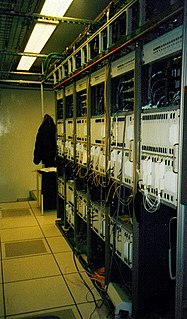
Synchronization is the coordination of events to operate a system in unison. For example, the conductor of an orchestra keeps the orchestra synchronized or in time. Systems that operate with all parts in synchrony are said to be synchronous or in sync—and those that are not are asynchronous.
The plesiochronous digital hierarchy (PDH) is a technology used in telecommunications networks to transport large quantities of data over digital transport equipment such as fibre optic and microwave radio systems. The term plesiochronous is derived from Greek plēsios, meaning near, and chronos, time, and refers to the fact that PDH networks run in a state where different parts of the network are nearly, but not quite perfectly, synchronized.

Synchronous optical networking (SONET) and synchronous digital hierarchy (SDH) are standardized protocols that transfer multiple digital bit streams synchronously over optical fiber using lasers or highly coherent light from light-emitting diodes (LEDs). At low transmission rates data can also be transferred via an electrical interface. The method was developed to replace the plesiochronous digital hierarchy (PDH) system for transporting large amounts of telephone calls and data traffic over the same fiber without the problems of synchronization.
In electronics and telecommunications, jitter is the deviation from true periodicity of a presumably periodic signal, often in relation to a reference clock signal. In clock recovery applications it is called timing jitter. Jitter is a significant, and usually undesired, factor in the design of almost all communications links.

Time-division multiplexing (TDM) is a method of transmitting and receiving independent signals over a common signal path by means of synchronized switches at each end of the transmission line so that each signal appears on the line only a fraction of time in an alternating pattern. This method transmits two or more digital signals or analog signals over a common channel. It can be used when the bit rate of the transmission medium exceeds that of the signal to be transmitted. This form of signal multiplexing was developed in telecommunications for telegraphy systems in the late 19th century, but found its most common application in digital telephony in the second half of the 20th century.

In fiber-optic communications, wavelength-division multiplexing (WDM) is a technology which multiplexes a number of optical carrier signals onto a single optical fiber by using different wavelengths of laser light. This technique enables bidirectional communications over a single strand of fiber, also called wavelength-division duplexing, as well as multiplication of capacity.
In telecommunications, a plesiochronous system is one where different parts of the system are almost, but not quite, perfectly synchronised. According to ITU-T standards, a pair of signals are plesiochronous if their significant instants occur at nominally the same rate, with any variation in rate being constrained within specified limits. A sender and receiver operate plesiosynchronously if they operate at the same nominal clock frequency but may have a slight clock frequency mismatch, which leads to a drifting phase. The mismatch between the two systems' clocks is known as the plesiochronous difference.

A radio clock or radio-controlled clock (RCC), and often (incorrectly) referred to as an atomic clock is a type of quartz clock or watch that is automatically synchronized to a time code transmitted by a radio transmitter connected to a time standard such as an atomic clock. Such a clock may be synchronized to the time sent by a single transmitter, such as many national or regional time transmitters, or may use the multiple transmitters used by satellite navigation systems such as Global Positioning System. Such systems may be used to automatically set clocks or for any purpose where accurate time is needed. RC clocks may include any feature available for a clock, such as alarm function, display of ambient temperature and humidity, broadcast radio reception, etc.

DCF77 is a German longwave time signal and standard-frequency radio station. It started service as a standard-frequency station on 1 January 1959. In June 1973 date and time information was added. Its primary and backup transmitter are located at 50°0′56″N9°00′39″E in Mainflingen, about 25 km south-east of Frankfurt am Main, Germany. The transmitter generates a nominal power of 50 kW, of which about 30 to 35 kW can be radiated via a T-antenna.
Transaction Language 1 (TL1) is a widely used management protocol in telecommunications. It is a cross-vendor, cross-technology man-machine language, and is widely used to manage optical (SONET) and broadband access infrastructure in North America. TL1 is used in the input and output messages that pass between Operations Support Systems (OSSs) and Network Elements (NEs). Operations domains such as surveillance, memory administration, and access and testing define and use TL1 messages to accomplish specific functions between the OS and the NE. TL1 is defined in Telcordia Technologies Generic Requirements document GR-831-CORE.
In computer networks, a network element is a manageable logical entity uniting one or more physical devices. This allows distributed devices to be managed in a unified way using one management system.
In telecommunication, a mesochronous network is a network in which the clocks run with the same frequency but unknown phases. Compare synchronous network.
Clock synchronization is a topic in computer science and engineering that aims to coordinate otherwise independent clocks. Even when initially set accurately, real clocks will differ after some amount of time due to clock drift, caused by clocks counting time at slightly different rates. There are several problems that occur as a result of clock rate differences and several solutions, some being more appropriate than others in certain contexts.
A passive optical network (PON) is a fiber-optic telecommunications technology for delivering broadband network access to end-customers. Its architecture implements a point-to-multipoint topology in which a single optical fiber serves multiple endpoints by using unpowered (passive) fiber optic splitters to divide the fiber bandwidth among the endpoints. Passive optical networks are often referred to as the last mile between an Internet service provider (ISP) and its customers.
Oscilloquartz, a company of ADVA Optical Networking, is a manufacturer of frequency sources, such as GPS& GLONASS receivers or caesium clocks for telecommunications applications and has been producing similar products for about 60 years. It also providers synchronization solutions for turnkey synchronization projects in e.g. PDH, SDH, SONET and all kind of mobile telecom networks e.g. GSM, X-CDMA, TETRA, 2.xG, 3G, 4G, UMTS, WiMAX.
Ethernet over PDH or EoPDH is one of many techniques that provided Ethernet connectivity over non-Ethernet networks. Specifically, EoPDH is a standardized methodology for transporting native Ethernet frames over the existing telecommunications copper infrastructure by leveraging the established PDH transport technology. EoPDH is one of several Ethernet transport technologies that enables Telecommunication Service Providers to offer "Carrier Ethernet" services. Also commonly used as a means of connecting businesses to a Metro Ethernet network.
G.811Timing characteristics of primary reference clocks is a recommendation from the ITU Telecommunication Standardization Sector (ITU-T). It specifies requirements for primary reference clock devices in synchronization networks. It discusses timing requirements for connecting national telecommunications networks. Primary reference clocks need to be highly accurate and are often based on caesium atomic clocks that meet the standards of G.811.
Synchronous Ethernet, also referred as SyncE, is an ITU-T standard for computer networking that facilitates the transference of clock signals over the Ethernet physical layer. This signal can then be made traceable to an external clock.
Two independent clocks, once synchronized, will walk away from one another without limit. To have them display the same time it would be necessary to re-synchronize them at regular intervals. The period between synchronizations is referred to as holdover and performance under holdover relies on the quality of the reference oscillator, the PLL design, and the correction mechanisms employed.

A GPS clock, or GPS disciplined oscillator (GPSDO), is a combination of a GPS receiver and a high-quality, stable oscillator such as a quartz or rubidium oscillator whose output is controlled to agree with the signals broadcast by GPS or other GNSS satellites. GPSDOs work well as a source of timing because the satellite time signals must be accurate in order to provide positional accuracy for GPS in navigation. These signals are accurate to nanoseconds and provide a good reference for timing applications.





